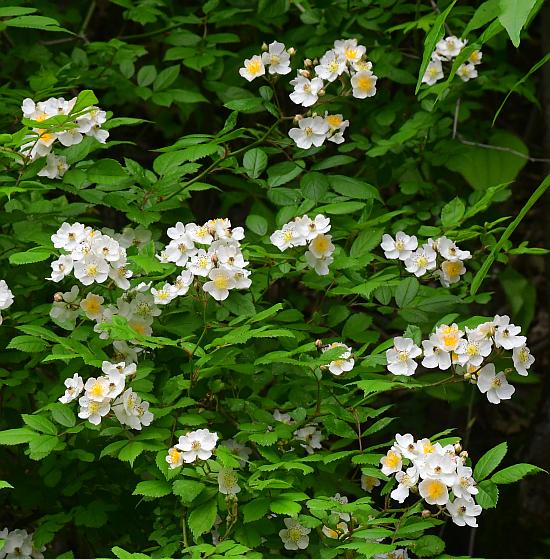Rosa multiflora Thunb.
Multiflora Rose

Introduced
CC = *
CW = 3
MOC = 60
© SRTurner
Rosa multiflora Thunb.Multiflora Rose | |
 |
Introduced CC = * CW = 3 MOC = 60 |
© SRTurner |
|
Family - Rosaceae Habit - Shrub, often climbing or leaning on other vegetation, from a branched taproot and stolons. Stems - Arching, sprawling, ascending, or erect, to 2.5 m, sometimes forming colonies, mostly relatively slender, green to reddish brown. Prickles paired at the nodes, 4-6 mm long, 2-3 mm wide, often broadened at the base, curved or rarely straight, flattened.
Leaves - Alternate, odd-pinnate, with 5-9 leaflets, 5-12 cm long, the petiole and rachis finely short-hairy and/or pubescent with longer more woolly hairs, usually with stalked glands and small prickles. Stipules 8-13 mm long, the margins deeply divided into numerous slender lobes, the auricle free, similar to the adjacent lobes, 4-8 mm long. Leaflets 10-45 mm long, 8-25 mm wide, the terminal leaflet with a stalk 7-13 mm long, the blades obovate to elliptic, angled at the base, angled or tapered at the tip, the margins simply or occasionally somewhat doubly toothed with 12-20 teeth per side, these rarely gland-tipped, the upper surface shiny or dull, glabrous or nearly so, green, the undersurface glabrous to more commonly finely hairy, especially along the midvein.
Inflorescences - Panicles of 5-30 flowers, on lateral branches from second year's stems and at tips of current year's growth, the flower stalks 5-12 mm long, woolly, especially toward the tip, with stalked glands but lacking prickles, with several to numerous bracts (these similar to the stipules, but shed before fruiting).
Flowers - Hypanthium 2-3 mm long, glabrous, sometimes with stalked glands, the mouth 0.5-1.0 mm in diameter. Sepals 6-10 mm long, 1.5-2.0 mm wide, all similar, the margins with slender lobes, the undersurface glabrous, but often with stalked glands, becoming reflexed and shed soon after flowering. Petals 7-13 mm long, white or less commonly pink. Pistils 6-11, the styles fused but sometimes becoming separated toward the tips, glabrous, extending 3-4 mm beyond the mouth of the hypanthium, thus protruding noticeably. Stamens numerous.
Fruits - Hips 5-7 mm long, 5-7 mm wide, ovoid to globose, orangish red to red, glabrous, lacking glands or with a few stalked glands. Achenes 1-11, tan, 3.8-5.0 mm long. Flowering - May - June. Habitat - Forests, streambanks, edges of marshes and fens, pond margins, prairies, pastures, fields, bases of bluffs, fencerows, railroads, roadsides, open disturbed areas. Also cultivated. Origin - Native to Japan. Lookalikes - Other species of Rosa. Other info. - This is a showy and visually attractive species for the week or so during which it is in bloom. Otherwise the plant is a serious pest, badly invading woodlands and crowding out native species with nasty, impenetrable thickets of brambles. It is found across most of Missouri, though uncommon in the northwestern quadrant of the state. It also occurs throughout the eastern half of the continental U.S., where many states consider it a noxious weed. It was legislatively designated as such in Missouri in 1983. Photographs taken at the Honey Creek Conservation Area, Andrew County, MO., 5-28-00 (DETenaglia); also near Labadie, Franklin County, MO, 5-19-2020, and at Route 66 State Park, St. Louis County, MO, 5-20-2020 (SRTurner). |